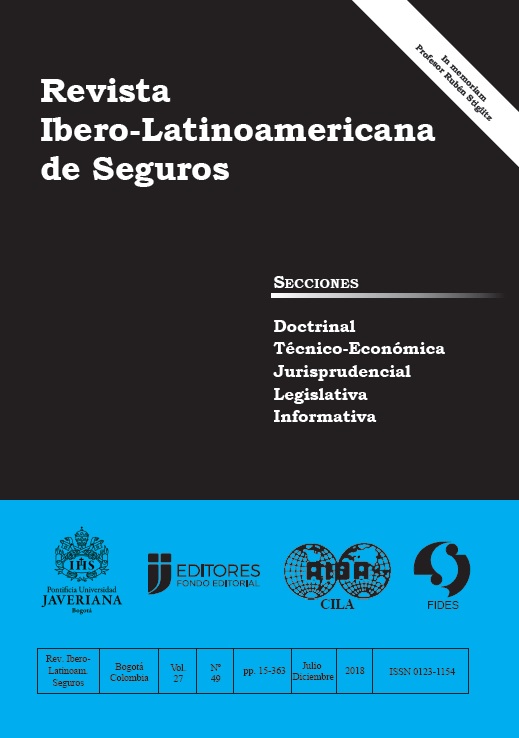Resumo
Este artículo establece, a partir de los documentos regulatorios Basilea II y Basilea III en sector el bancario y Solvencia II en el sector de seguros, qué es el riesgo operacional, cuáles son las características específicas en ambos mercados, cómo se gestiona dicho riesgo en uno y en otro y cuáles son los métodos de cálculo del mismo. A partir de esta información se realiza un análisis de las diferencias que se producen en los dos casos y se determinan los motivos que llevan a dichas diferencias.
- Basel Committee on Banking Supervision (2004). International Convergence of Capital Measurement and Capital Standards: a revised framework, nº 107. Basilea. Suiza. Disponible en: http://www.bis.org/publ/bcbs107.htm
- Basel Committee on Banking Supervision (2003). Sound Practices for the Management and Supervision of operational risk. Bank for International Settlements. Disponible en: http://www.bis.org/publ/bcbs96.htm
- Boller, P., Grégoire, C. y Kawano, T. (2016). Operational Risk en IAA Risk Book. International Actuarial Association. Disponible en: http://www.actuaries.org/index.cfm?lang=EN&DSP=PUBLICATIONS&ACT=RISKBOOK
- Comité de Supervisión Bancaria de Basilea (2005). Convergencia Internacional de Medidas y Normas de Capital. Marco Revisado. Disponible en: http://www.bis.org/publ/bcbs107esp.htm
- Committee of European Insurance and Occupational Pensions Supervisors (2009). Advice for Level 2 Implementing Measures on Solvency II: SCR standard formula - Article 111 (f) Operational Risk. CEIOPS-DOC-45/09.
- Cooper, B., Piwcewicz, B. y Warren, N. (2014). Operational risk modeling: how far have we progressed? Actuaries Institute. Financial Services Forum. Sydney
- European Insurance and Occupational Pensions Authority (2014). Guidelines on Own Risk and Solvency Assessment (ORSA). EIOPA-BoS-14/259 EN. Disponible en: https://eiopa.europa.eu/publications/eiopa-guidelines/guidelines-on-own-risk-solvency-assessment-(orsa)
- Oesterreichische Nationalbank (2016). Guidelines on Operational Risk Management. Vienna. Disponible en: https://www.oenb.at
- Pacheco López, D. (2009). Riesgo operacional: Conceptos y mediciones. Superintendencia de Bancos e Instituciones Financieras de Chile. Disponible en: https://www.sbif.cl/sbifweb/internet/archivos/publicacion_8511.pdf
Esta revista científica se encuentra registrada bajo la licencia Creative Commons Reconocimiento 4.0 Internacional. Por lo tanto, esta obra se puede reproducir, distribuir y comunicar públicamente en formato digital, siempre que se reconozca el nombre de los autores y a la Pontificia Universidad Javeriana. Se permite citar, adaptar, transformar, autoarchivar, republicar y crear a partir del material, para cualquier finalidad (incluso comercial), siempre que se reconozca adecuadamente la autoría, se proporcione un enlace a la obra original y se indique si se han realizado cambios. La Pontificia Universidad Javeriana no retiene los derechos sobre las obras publicadas y los contenidos son responsabilidad exclusiva de los autores, quienes conservan sus derechos morales, intelectuales, de privacidad y publicidad.
El aval sobre la intervención de la obra (revisión, corrección de estilo, traducción, diagramación) y su posterior divulgación se otorga mediante una licencia de uso y no a través de una cesión de derechos, lo que representa que la revista y la Pontificia Universidad Javeriana se eximen de cualquier responsabilidad que se pueda derivar de una mala práctica ética por parte de los autores. En consecuencia de la protección brindada por la licencia de uso, la revista no se encuentra en la obligación de publicar retractaciones o modificar la información ya publicada, a no ser que la errata surja del proceso de gestión editorial. La publicación de contenidos en esta revista no representa regalías para los contribuyentes.



